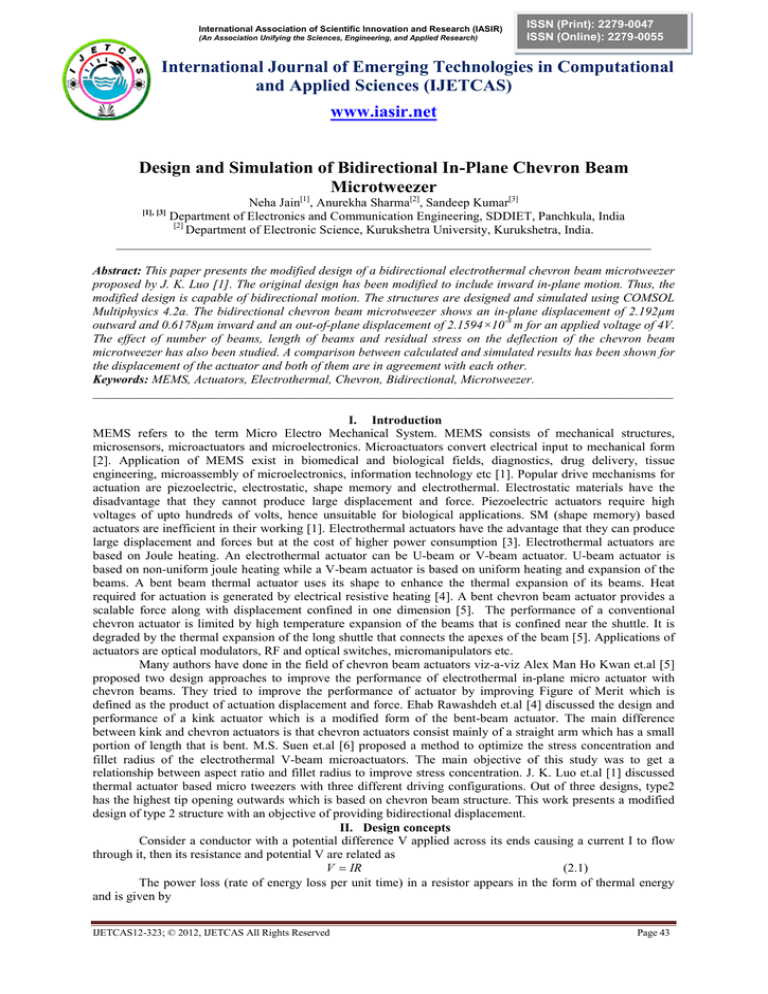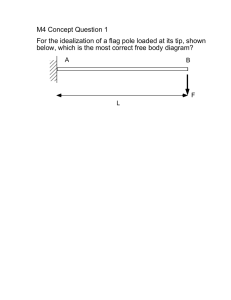
International Association of Scientific Innovation and Research (IASIR)
(An Association Unifying the Sciences, Engineering, and Applied Research)
ISSN (Print): 2279-0047
ISSN (Online): 2279-0055
International Journal of Emerging Technologies in Computational
and Applied Sciences (IJETCAS)
www.iasir.net
Design and Simulation of Bidirectional In-Plane Chevron Beam
Microtweezer
Neha Jain[1], Anurekha Sharma[2], Sandeep Kumar[3]
Department of Electronics and Communication Engineering, SDDIET, Panchkula, India
[2]
Department of Electronic Science, Kurukshetra University, Kurukshetra, India.
___________________________________________________________________________________
[1], [3]
Abstract: This paper presents the modified design of a bidirectional electrothermal chevron beam microtweezer
proposed by J. K. Luo [1]. The original design has been modified to include inward in-plane motion. Thus, the
modified design is capable of bidirectional motion. The structures are designed and simulated using COMSOL
Multiphysics 4.2a. The bidirectional chevron beam microtweezer shows an in-plane displacement of 2.192µm
outward and 0.6178µm inward and an out-of-plane displacement of 2.1594×10-8 m for an applied voltage of 4V.
The effect of number of beams, length of beams and residual stress on the deflection of the chevron beam
microtweezer has also been studied. A comparison between calculated and simulated results has been shown for
the displacement of the actuator and both of them are in agreement with each other.
Keywords: MEMS, Actuators, Electrothermal, Chevron, Bidirectional, Microtweezer.
__________________________________________________________________________________________
I. Introduction
MEMS refers to the term Micro Electro Mechanical System. MEMS consists of mechanical structures,
microsensors, microactuators and microelectronics. Microactuators convert electrical input to mechanical form
[2]. Application of MEMS exist in biomedical and biological fields, diagnostics, drug delivery, tissue
engineering, microassembly of microelectronics, information technology etc [1]. Popular drive mechanisms for
actuation are piezoelectric, electrostatic, shape memory and electrothermal. Electrostatic materials have the
disadvantage that they cannot produce large displacement and force. Piezoelectric actuators require high
voltages of upto hundreds of volts, hence unsuitable for biological applications. SM (shape memory) based
actuators are inefficient in their working [1]. Electrothermal actuators have the advantage that they can produce
large displacement and forces but at the cost of higher power consumption [3]. Electrothermal actuators are
based on Joule heating. An electrothermal actuator can be U-beam or V-beam actuator. U-beam actuator is
based on non-uniform joule heating while a V-beam actuator is based on uniform heating and expansion of the
beams. A bent beam thermal actuator uses its shape to enhance the thermal expansion of its beams. Heat
required for actuation is generated by electrical resistive heating [4]. A bent chevron beam actuator provides a
scalable force along with displacement confined in one dimension [5]. The performance of a conventional
chevron actuator is limited by high temperature expansion of the beams that is confined near the shuttle. It is
degraded by the thermal expansion of the long shuttle that connects the apexes of the beam [5]. Applications of
actuators are optical modulators, RF and optical switches, micromanipulators etc.
Many authors have done in the field of chevron beam actuators viz-a-viz Alex Man Ho Kwan et.al [5]
proposed two design approaches to improve the performance of electrothermal in-plane micro actuator with
chevron beams. They tried to improve the performance of actuator by improving Figure of Merit which is
defined as the product of actuation displacement and force. Ehab Rawashdeh et.al [4] discussed the design and
performance of a kink actuator which is a modified form of the bent-beam actuator. The main difference
between kink and chevron actuators is that chevron actuators consist mainly of a straight arm which has a small
portion of length that is bent. M.S. Suen et.al [6] proposed a method to optimize the stress concentration and
fillet radius of the electrothermal V-beam microactuators. The main objective of this study was to get a
relationship between aspect ratio and fillet radius to improve stress concentration. J. K. Luo et.al [1] discussed
thermal actuator based micro tweezers with three different driving configurations. Out of three designs, type2
has the highest tip opening outwards which is based on chevron beam structure. This work presents a modified
design of type 2 structure with an objective of providing bidirectional displacement.
II. Design concepts
Consider a conductor with a potential difference V applied across its ends causing a current I to flow
through it, then its resistance and potential V are related as
(2.1)
V = IR
The power loss (rate of energy loss per unit time) in a resistor appears in the form of thermal energy
and is given by
IJETCAS12-323; © 2012, IJETCAS All Rights Reserved
Page 43
Jain et al., International Journal of Emerging Technologies in Computational and Applied Sciences, 3(1), Dec.12-Feb. 13, pp. 43-49
(2.2)
=
P VI
= I 2R
This power is also known as ohmic heating or Joule heating. Power results in heating of the structure
which causes thermal expansion according to the equation 2.3.
(2.3)
∆L =α E L∆T
where,
α E = Thermal expansion coefficient
ΔT= Temperature difference
Figure 2.1: Chevron beam actuator
This elongation in the beam produces deflection of chevron beam actuator is given by equation 2.4 [7]:
(2.4)
Def chev = [ L2 + 2 L(∆L) − L2 cos 2 (α)]1/2 − L sin(α) where,
L= Length of single beam
α = Pre-bending angle
ΔL = Elongation of the beam due to thermal expansion [3], where ΔL is given by equation 2.3
Stiffness of the shuttle with N number of beams is given by the following equation [8]:
(2.5)
kCHV = N192 EI / (2 L) 2
where,
N=Number of beams
E= Young’s modulus
L= Length of beam
I= Moment of Inertia, which is given by [9]
I = tw3 / 12
(2.6)
where,
t= Thickness of beam in µm
w= Width of the beam in µm
III. Design and Simulation
The original structure [1] given in figure 3.1 shows an outward deflection. This structure consists of
chevron beam and inverted chevron beam design. The motion of the shuttle pushes the inverted chevron
structure upward and deflects the arms of the microtweezer outwards.
Figure 3.1: Original design
Figure 3.2: Proposed design for bidirectional motion
The design in fig. 3.1 is modified as shown in fig. 3.2 to provide bidirectional motion of microtweezer.
This structure consists of two inward chevron beam structures and one chevron beam structure which shows an
inward deflection when voltage is applied across contact pad 1 and it shows an outward deflection when voltage
is applied across contact pad 2. Contact pad 3 is provided with the potential in both the cases.
A. Simulation results
The structure given in figure 3.2 was designed and simulated in COMSOL 4.2a. The main beam and
chevron beam structures are made of polysilicon while the contact pads are made of copper. The material
properties of both the materials are given in table 3.1.
Table 3.1: Material properties
IJETCAS12-323; © 2012, IJETCAS All Rights Reserved
Page 44
Jain et al., International Journal of Emerging Technologies in Computational and Applied Sciences, 3(1), Dec.12-Feb. 13, pp. 43-49
Property
Electrical conductivity(σ) in S/m
Coefficient of thermal expansion(α) in 1/K
Heat capacity at constant pressure(Cp) in J/ kg*K
Density( ρ ) in kg/m3
Polysilicon
0.25×105
2.61×10-6
678
2320
Copper
58.1×106
16.5×10-6
384
8960
Thermal conductivity(k) in W/m*K
Relative permittivity (Ɛr)
Young’s Modulus(E) in GPa
Poisson’s ratio(µ)
34
4.5
160
0.22
401
4.5
120
0.34
Geometrical dimensions of proposed design are shown in table 3.2
Parameter
Table 3.2 Geometrical dimensions of proposed design
Dimensions
Length of anchors
50µm
Width of anchors
50µm
Length of chevron beam
150µm
Width of chevron beam
5µm
Length of inverted chevron
50µm
Width of inverted chevron
4µm
Length of main beam
900µm
Width of main beam
10µm
Tilt angles
5.71˚
Length of the shuttle
190µm
Gap between chevron beams
25µm
Gap between inverted chevron beams
10µm
Figure 3.3 and 3.4 shows displacement distributions for a bidirectional microtweezer which shows both
inward and outward displacement in a single structure. This is because this structure consists of both chevron
beams and inverted chevron beams in its design which can displace the tweezer in either direction based on to
which contact pads the voltage is applied. When a potential of 4V is applied across contact pad1 it shows an
inward displacement and when this voltage is applied across contact pad2 it shows an outward displacement.
Figure 3.3: Bidirectional microtweezer with inward displacement
Figure 3.4: Bidirectional microtweezer with outward displacement
Figure 3.5 and 3.6 shows the temperature distribution for bidirectional microtweezer. In this figure
structure reaches maximum temperature of 881K at an applied voltage of 4V while temperature at tips is
approximately at room temperature.
IJETCAS12-323; © 2012, IJETCAS All Rights Reserved
Page 45
Jain et al., International Journal of Emerging Technologies in Computational and Applied Sciences, 3(1), Dec.12-Feb. 13, pp. 43-49
Figure 3.5: Temperature distribution for inward deflection
Figure 3.6: Temperature distribution for outward deflection
Figure 3.7 shows variation of displacement with applied voltage for inward and outward deflection.
Figure 3.7: Voltage Vs displacement
Figure 3.8 shows variation in temperature on shuttle with applied voltage.
Figure 3.8: Voltage Vs temperature
Variation of displacement with number of beams
Figure 3.9 shows that as the number of beams increases displacement also increases up to five beams.
After that it almost saturates. This trend follows irrespective of change in length.
IJETCAS12-323; © 2012, IJETCAS All Rights Reserved
Page 46
Jain et al., International Journal of Emerging Technologies in Computational and Applied Sciences, 3(1), Dec.12-Feb. 13, pp. 43-49
Figure 3.9: Number of beams Vs Displacement
Figure 3.10 shows the variation in stiffness with number of beams.
Figure 3.10: Number of beams Vs stiffness
Figure 3.10 shows that upon increasing the number of beams for a chevron beam actuator, stiffness of
the beam also increases. This stiffness accounts for the limitation in increase in displacement with the increase
in number of beams. Residual stresses are introduced in the structures when thin films are deposited at an
elevated temperature. This can be compressive stress or tensile stress. In the present design we are using
polysilicon as the material, therefore stress induced here is compressive stress. As the compressive stress
increases structure becomes flexible. Hence displacement increases on increasing compressive stress. Figure
3.11 shows effect of compressive residual stress on displacement.
Figure 3.11: Residual stress Vs displacement
Figure 3.11 shows that as the compressive residual stress increases, the displacement of the
microtweezer also increases. In this work, for a compressive stress in the range 150MPa to 350MPa
displacement is increased from 0.3067µm to 2.156µm.
IV. Results and Discussions
Simulated versus calculated results for chevron beam actuator are shown in figure 4.1. It can be
observed that both the results are in agreement with each other.
IJETCAS12-323; © 2012, IJETCAS All Rights Reserved
Page 47
Jain et al., International Journal of Emerging Technologies in Computational and Applied Sciences, 3(1), Dec.12-Feb. 13, pp. 43-49
Figure 4.1: Simulated Vs calculated results
For fixed voltage, height and material properties, the displacement is proportional to the square of the
beam length. This is given by equation 4.1 [10]:
(4.1)
µ = βαL2V 2 / 3k ρd
where,
µ is the displacement, β represents difference in displacement for different actuators and its value is unity for
chevron beam actuator, α is thermal expansion coefficient, L is the length of the beam and V is the applied
potential.
Hence increasing the beam length is the effective way to achieve a larger displacement. But there is a
limitation on the beam length due to buckling and stiction problems, and the maximum displacement of a
chevron actuator is therefore limited [10]. The inward displacement and outward displacement for same applied
voltage is different due to the different lengths of the two chevron beams. Therefore, the bidirectional behaviour
can be easily tailored by optimising the lengths. Chevron is modelled as a doubly supported beam with rigid
ends. Effect of stiffness with number of beams has been studied and it is observed that as the number of beams
increases stiffness also increases. This is evident from figure 3.10. Hence in the modified design number of
chevron beams is limited to five, as beyond this there is no substantial increase in displacement. Effect of
compressive residual stress on displacement has also been studied. As the compressive stress is induced in the
structure flexibility of the beams increases, hence displacement of the actuator also increases. This is evident in
figure 3.11.
V. Conclusion
This paper presents the design and simulation of a bidirectional chevron beam microtweezer. The
presented design shows an out-of-plane displacement of 2.1594×10-8m which is very less as compared to inplane inward and outward displacement of 2.192µm and 0.6178µm respectively for applied voltage of 4V.
Effect of compressive residual stress is also studied on displacement and it is found that as the compressive
residual stress increases displacement also increases. Effect of stiffness is studied which indicates that number
of beams of the actuator is limited to five in this case.
Acknowledgement
One of the authors acknowledges the support of Dr. Dinesh Kumar, Dr. B. Prasad and Dr. Manish
Hooda in allowing her to use the design tools in NPMASS MEMS Design Centre, Electronic Science
Department, Kurukshetra University, Kurukshetra.
REFERENCES
[1]
[2]
[3]
[4]
[5]
[6]
[7]
[8]
J K Luo, A J Flewitt, S M Spearing, N A Fleck, and W I Milne, “Comparison of Microtweezers based on Three Lateral Thermal
Actuator Configurations”, Journal of Micromechanics and Microengineering, Vol 15, pp. 1294-1302, 2005.
Prime Faraday Partnership, 2002, “An Introduction to MEMS”, Standard Book, Loughborough University, Loughborough, UK.
Timothy Moultan and G. K. Ananthasuresh, “Micromechanical Devices with Embedded Electro-Thermal-Compliant Actuation”,
Sensors and Actuators A90, pp. 38-48, 2001.
Ehab Rawashdeh, Ayman Karam and Ian G. Foulds, “Characterization of Kink Actuators as Compared to Traditional Chevron
Shaped Bent-Beam Electrothermal Actuators”, Micromachines, Vol. 3, pp. 542-549, 2012.
Alex Man Ho Kwan, Sichao Song, Xing Lu, Lei Lu, Ying-Khai Teh, Ying-Fei Teh,Eddie Wing, Cheung Chong, Yan Gao,
William Hau, Fan Zeng, Man Wong, Chunmei Huang, Akira Taniyama, Yoshihide Makino, So Nishino, Toshiyuki Tsuchiya,
and Osamu Tabata, “Improved Designs for an Electrothermal In-Plane Microactuator”, Journal of
Micromechanical Systems, Vol. 21, No. 3, pp. 586-595, June 2012.
M.S. Suen, J.C. Hsien, K.C. Liu, David T.W. Lin, “Optimal Design of the Electrothermal V-Beam Microactuator Based on GA
for Stress Concentration Analysis”, Proceedings of the International Multiconference of Engineers and Computer Scientists 2011
Vol II, IMECS, 2011.
Jorge Varona, Margarita Tecpoyotl-Torres, Anas A. Hamoui, “Design of MEMS vertical-horizontal chevron thermal actuators”,
Sensors and Actuators A: Physical, Vol. 153, pp. 127-130, 2009.
Yongjun Lai, James McDonald, Marek Kujath and Ted Hubbard, “Force, deflection and power measurements of toggled
microthermal actuators”, Journal of Micromechanics and Microengineering, Vol. 14, pp. 49-56, 2004.
IJETCAS12-323; © 2012, IJETCAS All Rights Reserved
Page 48
Jain et al., International Journal of Emerging Technologies in Computational and Applied Sciences, 3(1), Dec.12-Feb. 13, pp. 43-49
[9]
[10]
[11]
[12]
[13]
[14]
[15]
[16]
La Vern A. Starman, Derrick Langley, Stanley Rogers, “Micro-Shutter Developments for IR Applications”, In Adaptive Coded
Apertures Imaging and Non-imaging Sensors, Edited by David P. Casasent, Stanley Rogers, Proceedings of SPIE Vol. 7096,
2006.
J K Luo, A J Flewitt, S M Spearing, N A Fleck, and W I Milne, “Three types of planarstructure microspring electro thermal
actuators with insulating beam constraints”, Journal of Micromechanics and Microengineering, Vol. 15, pp. 1527-1535, 2005.
A.A. Aziz, M.S. Rehman, and Hasnizah Aris, “Finite Element Analysis of a LateralMicroelectrothermal Actuator”, RSM
Proceedings, pp. 354-358, 2011.
Leslie M Phinney, Matthew A Spletzer, Michael S Baker and Justin R Serrano, “Effects of mechanical stress on thermal
microactuator performance”, Journal of Micromechanics and Microengineering, Vol. 20, pp. 1-7, 2010.
Jay J. Khazaai, M. Haris M. Khir, Hongwei Qu, James Slicker, “Design and Fabrication of a Low Power Electro-thermal Vshape Actuator with Large Displacement”, NSTI-Nanotech, Vol. 2, pp. 681-684, 2010.
Kristian Molhave and Ole Hansen, “Electro-thermally actuated microgrippers with integrated force-feedback”, Journal of
Micromechanics and Microengineering, Vol. 15, pp. 1265-1270, 2005.
Nilesh D Mankame and G K Ananthasuresh, “Comprehensive Thermal Modeling and Characterization of an Electro-thermal
compliant Microactuator”, Journal of Micromechanics and Microengineering, Vol. 11, pp. 452-462, 2001.
Qing-An Huang and Neville Ka Shek Lee, “Analysis and design of polysilicon thermal flexure actuator”, Journal of
Micromechanics and Microengineering, Vol. 9, pp. 64-70, 1999.
IJETCAS12-323; © 2012, IJETCAS All Rights Reserved
Page 49


